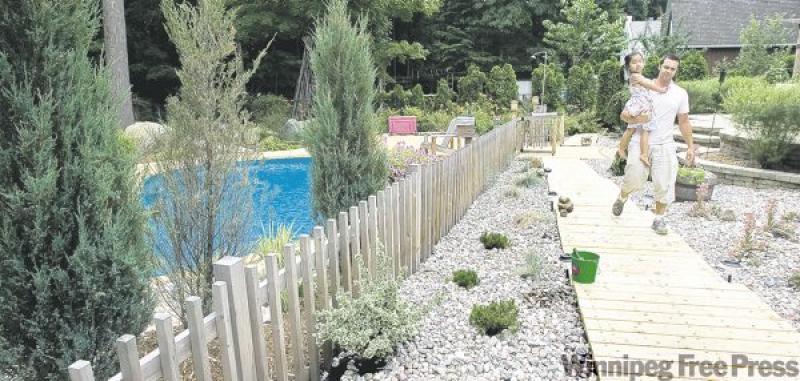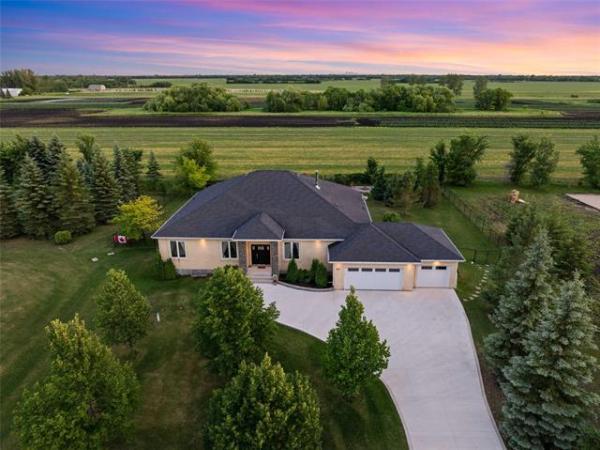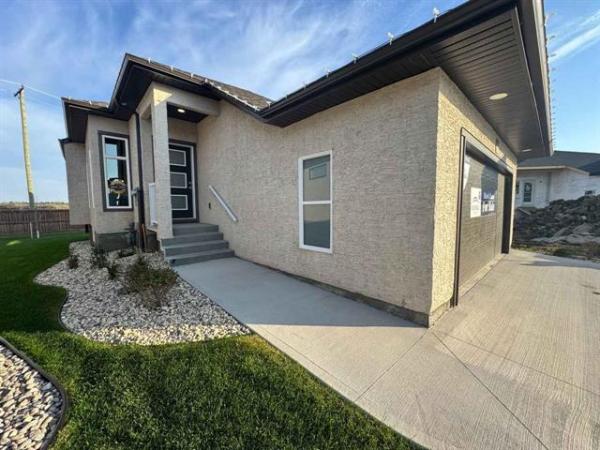So when Julie Jonas and Danny Roberge were designing their garden, they decided it would be a lawn-free landscape. Where there was once grass, there is now a Zen-like melange of shrubs, trees, berms, patios, walkways and stones.
"Everything about Danny is efficient and practical," Jonas said. "For him, grass represented maintenance and watering."
Preserving the environment is a key value that has driven them both in their careers. Jonas owns Zia and Tia Pure Luxury Organics, an e-commerce company that sells organic products. Roberge runs Skinnimini Edibles, the couple's vegan baked goods company.
Jonas and Roberge were new to gardening when they moved into their two-storey house in 2001 and they were unaware of the "xeriscaping" trend, which is the practice of creating landscapes that require no extra watering. Many of the plants they've chosen are drought-tolerant and the only ones that get watered are several pots of annuals, which include petunias and scaevola, a cascading blue-flowered plant.
As their garden has evolved, it has also become an excellent spot for chilling out, thanks to the in-ground swimming pool in the backyard, installed two years ago; and for entertaining, thanks to the large patio behind the house.
Because she knew nothing about garden design and horticulture, Jonas consulted a couple of garden design firms, neither of which was able to translate onto a plan the design she saw in her mind.
"They kept giving me plans that featured mass plantings of hostas. It wasn't what I wanted," she said.
Still, she got to work planting borders of perennials around the perimeter of the grassed backyard.
But as time passed, the grass became increasingly undesirable. For one thing, it was being ruined by white grubs, which create brown patches as they destroy the roots. And for another, there were swarms of mosquitoes, which tend to live in damp lawns.
So in 2002, Jonas and Roberge got to work, deturfing the 13,000-square-foot lot.
"At first, we didn't look at it from an environmental point of view," Jonas said.
But they soon realized they would no longer have to water or mow.
Jonas's love of all things Asian became the foundation of the garden's new aesthetic. The backyard is dominated by a raised stone patio, which is the centre of the family's social life during the summer. In one corner, a garden shed mimics the look of a pagoda with its bamboo columns and sheltered terrace. The couple put a futon on the terrace and it's become a favourite reading nook in warm weather.
They considered installing a pond but changed their mind after travelling to China to adopt their daughter, Zia, in 2004, fearing it might be a safety hazard for a small child. Instead, they had an in-ground swimming pool installed two years ago. The earth that was excavated to build it was set aside in part of the yard. It now forms a berm that has been planted with a collection of shrubs.
The challenge in installing the pool was the fact the house has a septic tank and no one knew how far its tiles extended.
"What we did was we replaced the old septic system with a new one that has a special ultra-violet lamp, which kills bacteria. It eliminates the need for weeping tiles," Roberge said.
On top of the new septic field, the couple spread river rocks and planted a collection of various drought-tolerant sedums and sempervivums, fleshy-leafed plants that thrive in dry conditions.
"I wanted to do a desert scene," Jonas said.
In other areas of the garden, yuccas and various cultivars of grasses are also a low-maintenance alternative to perennials that require water.
There have been a few surprises in the garden's evolution, including the rapid growth of many of the shrubs and small trees. Beside the pagoda-like shed, they planted an American elder, an attractive shrub-like tree, which grew rapidly and within two years, had filled a corner of the yard. They also discovered that they like a garden devoted to foliage and textures rather than the colours conferred by the blooms of perennials. To create a landscape of varying foliages, they planted groupings of shrubs that include variegated willows, pink-flowering spireas, hemlocks, spruces, pines, hydrangeas, junipers and potentillas.
The other surprise was the wild animals that have been attracted to the garden. The house backs onto a 22-hectare undeveloped tract of land that is home to much wildlife. Chipmunks, raccoons, pileated woodpeckers, chickadees and white squirrels are regular visitors. And coyotes have been spotted in the neighbourhood.
"Moles sometimes fall into the swimming pool and frogs often hop in," Jonas said, adding, "we put an animal rescue pad in the pool so that they could save themselves by climbing on it, but they don't use it. We have to fish them out."
The least welcome critters are the many snakes that live in the collection of grasses, planted for drought tolerance, and among the rocks that decorate the property.
"We saw our first snake three years ago and every year, we've seen more and more," Jonas said. "We obviously have fantastic living conditions for them. There's probably food for them in the form of moles and mice."
Roberge has created much of the hardscaping around the house. Because the couple wanted to create a landscape that would allow them to walk barefoot outdoors, he built wooden walkways that allow them to walk through the backyard and around the sides of the house. They add to the garden's Asian ambiance.
While Jonas and Roberge work hard in the garden in the spring to prepare it for the growing season, there is little maintenance to do throughout the summer.
"Once our work is finished, we sit here and watch things grow," Jonas said.
-- Canwest News Service




